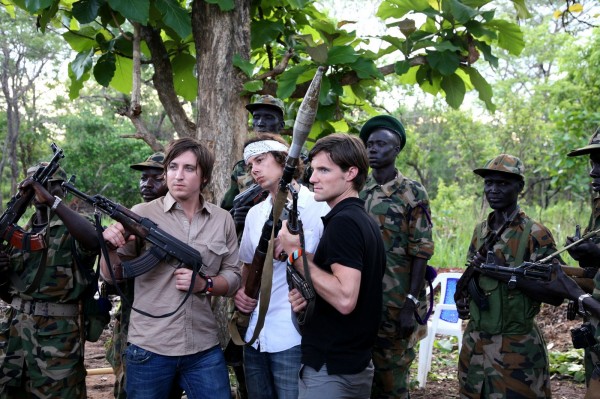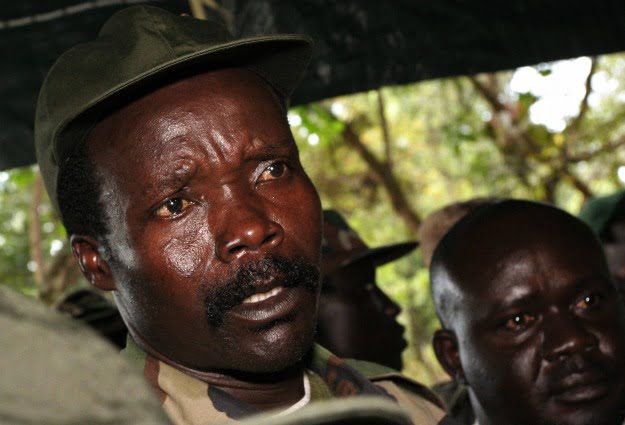Thanks to an incredibly effective social media effort, #StopKony is trending today. The campaign coincides with a new awareness-raising documentary by the group Invisible Children. Former FP intern Michael Wilkerson, now a freelance journalist and Ph.D. candidate at Oxford — who has lived and reported from Uganda — contributed this guest post. -JK
By Michael Wilkerson:
“Joseph Kony is basically Adolf Hitler. He has an army of 30 000 mindless children who slaughter innocent people in Uganda.”
Have you seen something like that fly across your Twitter or Facebook feed today? Or perhapsthis?:
“#TweetToSave the Invisible Children of Uganda! #Kony2012 Make Joseph Kony Famous!!”
“Kony 2012,” a video posted by advocacy group Invisible Children to raise awareness about the pernicious evil of Lord’s Risistance Army (LRA) leader Joseph Kony, has already been viewed over8 million times on Vimeo and more than 9 million times on YouTube (and surely more by the time you read this) since its release this week.
It would be great to get rid of Kony. He and his forces have left a path of abductions and mass murder in their wake for over 20 years. But let’s get two things straight: 1) Joseph Kony is not in Uganda and hasn’t been for 6 years; 2) the LRA now numbers at most in the hundreds, and while it is still causing immense suffering, it is unclear how millions of well-meaning but misinformed people are going to help deal with the more complicated reality.
First, the facts. Following a successful campaign by the Ugandan military and failed peace talks in 2006, the LRA was pushed out of Uganda and has been operating in extremely remote areas of the DRC, South Sudan, and the Central African Republic — where Kony himself is believed to be now. The Ugandan military has been pursuing the LRA since then but had little success (andseveral big screw-ups). In October last year, President Obama authorized the deployment of 100 U.S. Army advisors to help the Ugandan military track down Kony, with no results disclosed to date.
Additionally, the LRA (thankfully!) does not have 30,000 mindless child soldiers. This grim figure, cited by Invisible Children in the film (and by others) refers to the total number of kids abducted by the LRA over nearly 30 years. Eerily, it is also the same number estimated for the total killed in the more than 20 years of conflict in Northern Uganda.
As I wrote for FP in 2010, the small remaining LRA forces are still wreaking havoc and very hard to catch, but Northern Uganda has had tremendous recovery in the 6 years of peace since the LRA left.

So why is “Uganda” trending on Twitter?
Unfortunately, it looks like meddlesome details like where Kony actually is aren’t important enough for Invisible Children to make sure its audience understands. The video, narrated by Invisible Children co-founder Jason Russell, says its purpose is to intensify pressure on the U.S. government to make sure Kony is brought to justice this year, and as the message broadcast throughout says, what is important is simple: Stop Kony.
Among other emotive shots, the video features Russell’s attempt to explain the LRA to his toddler son, enthusiastic (and mostly white) volunteers putting up posters and wearing Kony 2012 bracelets, and some heart-wrenching footage of children who walked for miles to sleep in a safe place at the height of the LRA’s power in Northern Uganda. The latter comprised much of Invisible Children’s namesake first film and brought the organization to prominence.
But in the new film, Invisible Children has made virtually no effort to inform. Only once, at 15:01 in the movie, over an image of a red blob on a map leaving Northern Uganda and heading West, is the fact that the LRA is no longer in Uganda mentioned, and only in passing:
“As the LRA begain to move into other countries, Jacob [one of the children filmed in Northern Uganda in 2003] and other Ugandans came to the US to speak on behalf of all people suffering because of Kony. Even though Uganda was relatively safe they felt compelled to tell the world that Kony was still out there and had to be stopped.”
That’s it, in a 30-minute movie. And with both the graphic and reiteration of how awful the LRA is, you might think reasonably “move into other countries” meant expanding rather than fleeing. In any case, the focus, seconds later, is on Invisible Children’s activities in the U.S. at the time, not what was happening back in Africa. I can see why some of P. Diddy’s followers might be confused.
Award-winning Ugandan journalist Angelo Izama is among those not thrilled:
“To call the campaign a misrepresentation is an understatement. While it draws attention to the fact that Kony, indicted for war crimes by the International Criminal Court in 2005, is still on the loose, its portrayal of his alleged crimes in Northern Uganda are from a bygone era. At the height of the war between especially 1999 and 2004, large hordes of children took refuge on the streets of Gulu town to escape the horrors of abduction and brutal conscription to the ranks of the LRA. Today most of these children are semi-adults. Many are still on the streets unemployed. Gulu has the highest numbers of child prostitutes in Uganda. It also has one of the highest rates of HIV/AIDS and Hepatitis.
If six years ago children in Uganda would have feared the hell of being part of the LRA, a well documented reality already, today the real invisible children are those suffering from “Nodding Disease”. Over 4000 children are victims of this incurable debilitating condition. It’s a neurological disease that has baffled world scientists and attacks mainly children from the most war affected districts of Kitgum, Pader and Gulu.”
Along with sharing the movie online, Invisible Children’s call to action is to do three things: 1) sign its pledge, 2) get the Kony 2012 bracelet and action kit (only $30!), and 3) sign up to donate.
There is intense criticism out there over Invisible Children’s finances, including that it spends too much money on administration and filmmaking, while still touting its on the ground NGO-style projects. Also, apparently it’s never been externally audited. I’m going to stay out of that, other than to say you can check out IC’s own financial disclosure information here.
What worries me more is that it’s unclear what exactly Invisible Children wants to do, other than raise a lot of money and attention. Here’s Russell in the video (21:40):
“We know what to do. Here it is, ready? In order for Kony to be arrested this year, the Ugandan military has to find him. In order to find him, they need the technology and training to track him in the vast jungle. That’s where the American advisors come in. But in order for the American advisors to be there, the American government has to deploy them. They’ve done that, but if the government doesn’t believe the people care about Kony, the mission will be cancelled. In order for the people to care, they have to know. And they will only know if Kony’s name is everywhere.
So the goal is to make sure that President Obama doesn’t withdraw the advisors he deployed until Kony is captured or killed. That seems noble enough, except that there has been no mention by the government of withdrawing those forces — at least any I can find. Does anyone else have any evidence about this urgent threat of cancellation? One that justifies such a massive production campaign and surely lucrative donation drive?
There are many reasons uninformed and oversimplified advocacy can cause trouble, and Siena Antsis catalogues some of them here, noting that Invisible Children expertly “commodifies white man’s burden on the African continent.” Buy a bracelet, soothe some guilt.
But as researcher Mark Kersten notes, after “stopping Kony”, then what? Or what if the activism just results the the 100 U.S. advisors staying but no Kony?
One of the biggest issues with a simplistic “Stop Kony” message is that discussions of Navy Seals or drone strikes are inevitable when patience runs out with Ugandan-led efforts . But what about the dozens or hundreds of abducted and brainwashed kids? Should we bomb everyone? Will they actually stop fighting after Kony is gone? What if they shoot back?
Coming back to the “Kony 2012” video and its celebrity endorsements, what are the consequences of unleashing so many exuberant activists armed with so few facts? Defining Uganda in the international conversation by issues that are either geographical misfires (Save northern Uganda!) or an intentional attempt to distract the international community (Death to the gays!), do a disservice to the many critical problems Uganda has.
In addition to the problems of poverty and nodding disease Izama highlights, Uganda is barely (if at all) democratic, and the president Yoweri Museveni ushered himself to a 4th term last year, taking him to over 25 years in power. Corruption is rampant, social services are minimal, and human rightsabuses by the government common and well documented. Oh, and oil is on the way.
Stopping Kony won’t change any of these things, and if more hardware and money flow to Museveni’s military, Invisible Children’s campaign may even worsen some problems.
Here’s to hoping Kony hands himself in tomorrow and that the fear of the U.S. “cancelling” its LRA-hunt support is misplaced. But if the most impactful the result of Invisible Children’s campaign is to cause millions of viewers to think Northern Uganda is a war zone, even if it’s not their intent, it’s hard to defend.






